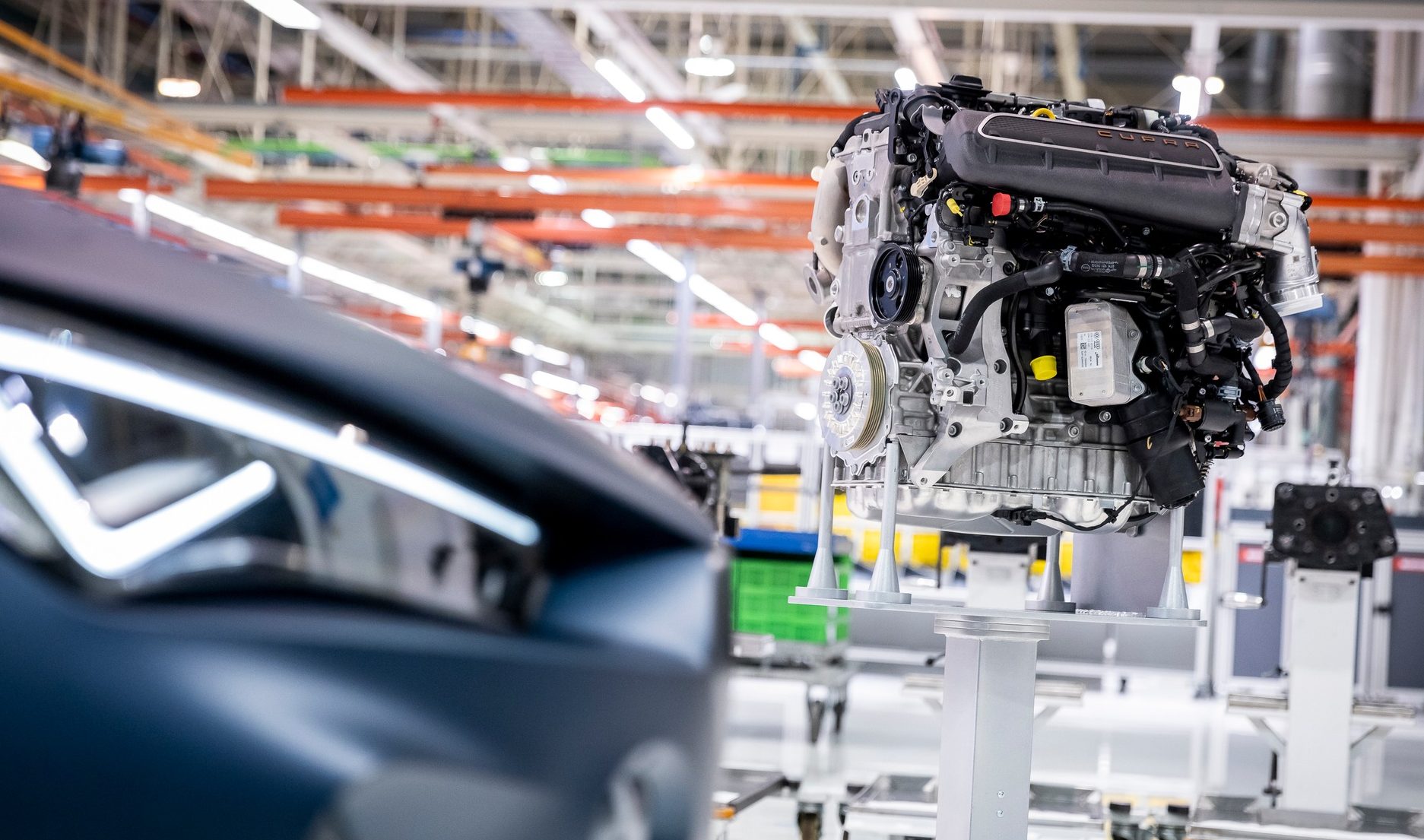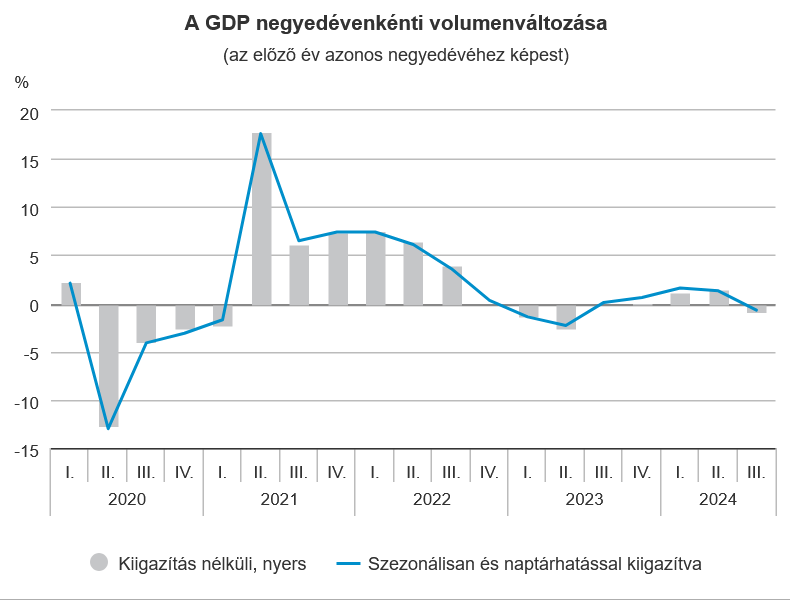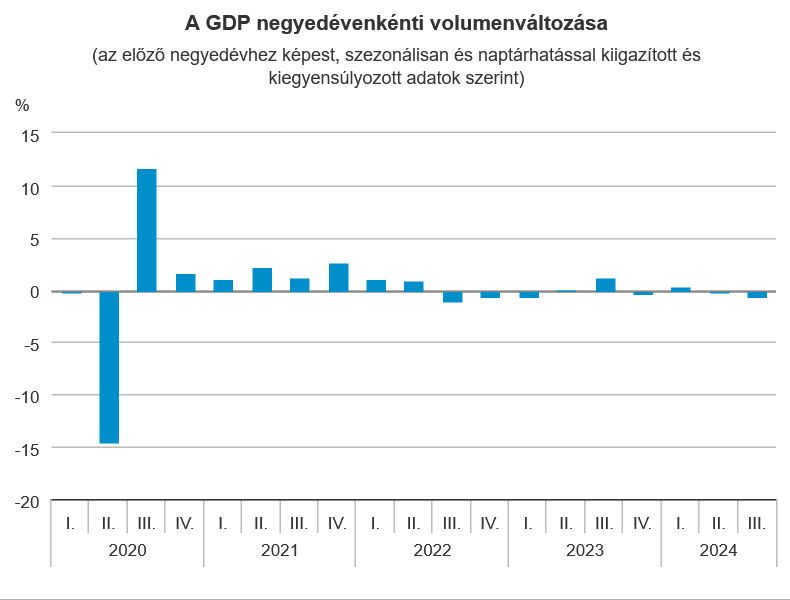
According to the Finance Minister, gross wage could increase by 8.6 percent next year.Continue reading

The third quarter GDP data came as a huge negative surprise, as reported by the Hungarian Central Statistical Office (KSH). Compared to the previous quarter, the economy’s performance fell by 0.7%. However, Prime Minister Viktor Orbán talked in an interview about the fact that in the next few years we can expect intensive growth and that the whole of Europe can recover, writes Magyar Nemzet.
“We are producing the world’s most modern cars, the defense industry has built up huge capacity, and there is growing output in the space industry. There is nothing wrong with Hungarian industry,” Viktor Orbán told Kossuth Radio’s Vasárnapi újság program. The Prime Minister noted that there is a trade problem:
when there is trouble on the world market, our customer base narrows.
The world economy is in a tailspin, but in the coming years electric cars and batteries will be needed. This will lead to intense growth, he added.
Prime Minister Orbán expressed hope that the BMW plant will start operations in the next period, and if battery production also starts up and the world economy stabilizes, the European economy could also recover. “If they cannot buy our products in the West, they should buy them in the East – it is necessary for the recovery,” the politician underlined.
He said that employers and employees must agree on wages, and that the new head of the Hungarian Chamber of Commerce and Industry, Elek Nagy, could help in this. On the workers’ loan, which will be available from January, he emphasized that there are 300,000 young people who will be eligible for the interest-free loan. Hungary wants to support not only young people in education but also young people in work, he added.
Viktor Orbán stressed that large companies are stable and large industrial production capacities have already been built up. “Construction companies are strong and Hungarian firms are carrying out major projects abroad. For medium-sized companies, the aim is to be able to enter the international market,” he added. According to the Prime Minister, small businesses are currently finding it difficult to thrive, so the Sándor Demján program is aimed at supporting them. Under the initiative, the state participates in businesses through a deposit loan and can increase their capacity through member loans.
The Prime Minister’s words coincide with the publication of data by the Central Statistical Office. As reported by KSH, Hungary’s gross domestic product (GDP) in the third quarter was 0.8% below the same period a year earlier in raw data and 0.7% in seasonally and calendar-adjusted and balanced figures. Compared to the previous quarter, the output of the economy fell by 0.7%. In the first three quarters, the indicator was 0.6% higher than in the same period of the previous year according to raw data and 0.7% higher according to seasonally and calendar adjusted and balanced data.
In the third quarter of 2024, euro area GDP grew by 0.4% and EU GDP by 0.3% compared with the previous quarter. This represents a marginal improvement on the previous figure. Based on the data available, Ireland recorded the largest increase compared with the previous quarter (+2.0%), followed by Lithuania (+1.1%) and Spain (+0.8%). Decreases were registered in Hungary (-0.7%), Latvia (-0.4%) and Sweden (-0.1%).

Quarterly volume change in GDP compared to the same quarter of the previous year. Graph: KSH
In mid-October Márton Nagy, the Minister for National Economy, stressed that he anticipated worse-than-market expectations for quarterly growth, as he said GDP growth would be closer to zero. Some analysts had already predicted that the third-quarter GDP data would be so bad that annual growth would be around stagnation.
However, even the most pessimistic analysts’ expectations were exceeded by last week’s data, leaving questions over whether annual average growth of 1% is achievable, let alone the 1.5-1.8% range.
So far, output has risen by a total of 0.7% in the first three quarters. So to reach the 1% annual average GDP expansion would require a bigger bounce in the last quarter, but there are no signs of that.

Quarterly volume change in GDP compared to the previous quarter, based on seasonally and calendar adjusted and balanced data. Graph: KSH
Although the detailed data will not be released by the KSH until later, it did reveal this much: The combined output of agriculture, industry and construction, accounting for nearly a third of the national economy, contributed to the year-on-year decline in gross domestic product by around two percentage points.
The government has already pointed out that the performance of the Hungarian economy will be weaker in the third quarter.
The main reasons for this were declines in construction and agriculture, but the weak performance of industry should also be highlighted, which is linked to the prolonged crisis in the German economy,
the Minister for National Economy emphasized. The problems in industry were not unknown, but the construction sector produced disappointing figures in August, despite the fact that the sector’s order books are already up by 20%. Agriculture is also thought to have suffered from the summer’s severe drought, with output in these three sectors falling so much that it pulled back total output.
Only domestic consumption and services (logistics, tourism, infocommunications and financial) are showing some strength, at least according to the retail sales data. The decline was held back by the performance of both market and non-market services.
Márton Nagy noted that, overall, we are clearly seeing an increase in consumption and a recovery in the domestic economy, which will have an increasingly strong impact in the coming months. This contrasts with the weakness of the external environment, with the German economy faltering. He pointed out that it was not yet clear when the German economy would be able to pull itself back together, which would have a positive impact on GDP growth.
In the light of all this, the economic policy question arises as to whether Hungary’s high dependence on the German economy is beneficial for Hungary, and the answer to this question is economic neutrality.
In the minister’s view, there is a clear need to reduce dependence and diversify, hence in addition to the West, Hungary’s economic relations with the East, currently showing much higher growth, should also be strengthened.
To conclude, the future could change according to analysts speaking to Világgazdaság. A more balanced growth structure is expected in 2025, but that would require industry and construction to find their feet as soon as possible. Current expectations are that a turnaround could come for several sectors, while wage dynamics will remain robust, meaning that domestic consumption will also maintain its momentum. All of these factors mean that 3% economic growth does not seem out of reach, and the precise impact of the government’s stimulus package announced in mid-October is not yet known.
Via Magyar Nemzet, Világgazdaság; Featured image via Facebook/Audi Hungaria Győr